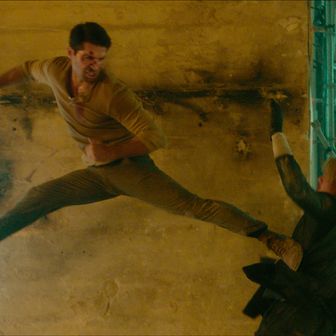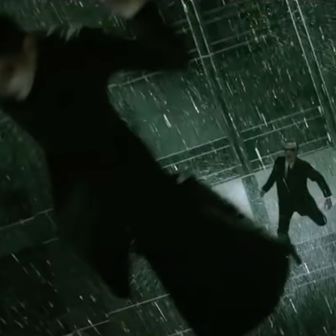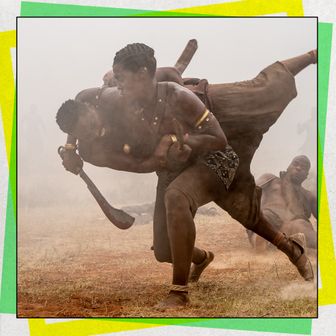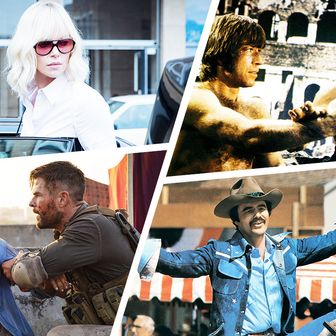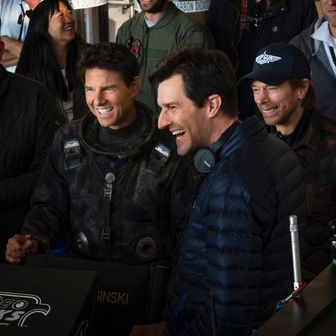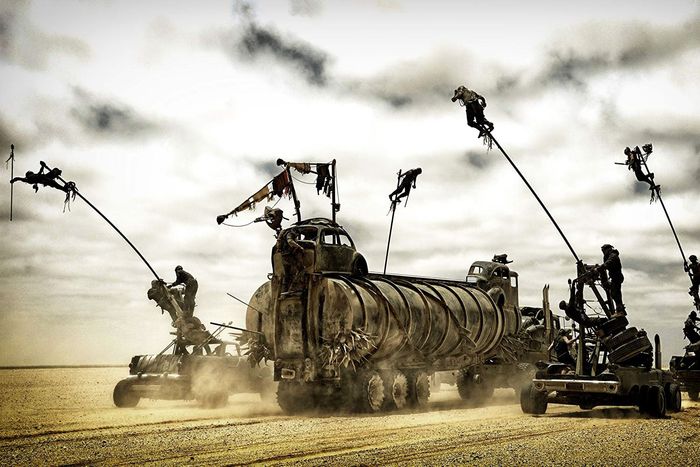
This article originally ran in 2019. We are republishing it on the occasion of Vulture’s inaugural Stunt Awards.
Believe it or not, it was all Sidney Lumet’s idea. In 1991, while working on A Stranger Among Us, the legendary director of Network, Dog Day Afternoon, and 12 Angry Men wondered aloud to his stunt coordinator Jack Gill why there was no Oscar category for stunt work. When Gill had no answers for him, Lumet decided the first step would be to sponsor him for membership in the Academy of Motion Picture Arts and Sciences (AMPAS). There, Gill learned that in order to be considered for an Oscar category, he’d first need to have a stunts branch established, then get enough members in that branch to potentially vote for nominations in the category. AMPAS higher-ups told him the process “could take as long as three or four years.”
That was over 30 years ago. Gill is still trying to get the Oscars to recognize stunts. Which is a bit surprising when you consider that during that time (1) the film industry has become completely dominated by action movies, which are heavily reliant on stunts, and (2) the Oscars have struggled with decreased viewership and an increased sense of irrelevance, as evidenced by their occasional attempts to find ways to honor more big blockbusters. You would think the Academy’s Board of Governors would have put two and two together by this point and established a Best Stunts category. But no. “When I first approached them, they were extremely eager to help,” Gill says. “As the years went on, they got tired of me. Now it’s hard to even get a meeting.”
Oscar’s cold shoulder notwithstanding, there has always been a whiff of romance around the figure of the Hollywood stuntman. “Throw him off a building, light him on fire, hit him with a Lincoln! He’s just happy for the opportunity,” Leonardo DiCaprio’s weathered actor Rick Dalton says of his easygoing stunt double Cliff Booth (Brad Pitt) in Quentin Tarantino’s Once Upon a Time in Hollywood. (The movie marks yet another entry in the director’s ongoing fascination with stuntpeople. See also: 2007’s Death Proof, which featured real-life stuntwoman Zoe Bell playing a fictional version of herself doing battle with a psychotic stuntman played by Kurt Russell. They appear as a husband-and-wife stunt duo in Once Upon a Time.) In one of the film’s more touching scenes, we see the poverty in which Cliff lives — in a cluttered, rundown trailer, eating (admittedly delicious-looking) instant mac and cheese, in sharp contrast to his movie-star boss and best friend. It’s a sly acknowledgement that Cliff pretty much does everything yet sees few of the upsides. Even at the end — spoiler alert — after the carnage of the finale, we see Cliff being taken away in an ambulance, while Rick reaps the benefits of his actions and appears to get a newfound lease on his floundering career.
Nowadays, we are a bit more aware of the people who crash cars and fall out of planes and get beaten and broken for our entertainment. We marvel at the highly coordinated carnage of the John Wick movies, the automotive antics of the Fast & Furious series, and the all-around how-did-they-do-that insanity of a Mad Max: Fury Road. Stories about the doubles on these sets go viral, as does behind-the-scenes footage of all the crazy shit they’ve had to do. Stunts are even used to market these pictures. The Mission: Impossible franchise has been sold to us largely on the power of its real-life stunts. And while it’s Tom Cruise, movie star, doing them, who do you think makes sure the Cruiser doesn’t break his neck? “Tom Cruise himself is basically an amazing stuntman,” says Janene Carleton, who has worked with the actor on Jack Reacher and Mission: Impossible — Ghost Protocol. (She has also done Pirates of the Caribbean films and Planet of the Apes films and has doubled everyone from Jennifer Lawrence to Kate Winslet to Jessica Biel.) “There are a handful of actors that do like to do their own stunts. But they still have a stunt team that designs the action, rehearses it over and over again to determine what looks the coolest, what hurts the most, what’s the safest. They train the actor for months. And even if the actor does it, the double does it as well, so they can edit it together. The stunt coordinators are responsible for keeping everyone safe.”
Some stunt professionals have even graduated to helming entire features. The first John Wick was directed by former coordinators David Leitch and Chad Stahelski. Subsequent entries were directed solo by Stahelski (himself formerly Keanu Reeves’s double on films like The Matrix), while Leitch has gone onto direct Atomic Blonde, Deadpool 2, and the new Fast & Furious spinoff, Hobbs & Shaw.
Meanwhile, stunts are being honored more and more by other parts of the industry. In 2007, the Screen Actors Guild introduced a Best Stunt Ensemble award. The Academy of Canadian Cinema & Television, that country’s equivalent of AMPAS, announced just several weeks ago a new award for Best Stunt Coordination. Stunt performer and coordinator Angelica Lisk-Hann, who helped lead that push, says that, unlike Gill’s decades-long struggle with AMPAS, her group’s 18-month effort was a relatively smooth process. “It’s too bad that it’s not the same down south,” she says. “All of us here are kind of shocked.” Stunt performers in the U.S. certainly aren’t happy about it either: Many of them boycotted the Oscars ceremony earlier this year, and they’re now considering a protest at next year’s.
But several stuntmen have won special Oscars before. Yakima Canutt, the legendary rodeo rider who doubled for John Wayne and coordinated stunts for Stagecoach, Gone With the Wind, and Ben-Hur (he’s the one who staged the chariot race), received an honorary Oscar in 1967 for his contributions to the craft. Vic Armstrong, who doubled Harrison Ford in Raiders of the Lost Ark and supervised countless major productions (including, in recent years, several Marvel films), won a technical-achievement award from the Academy for his pioneering use of a device called the fan descender, which made high free falls safer. Hal Needham, a stuntman turned director who struck gold with Smokey and the Bandit and for many years was Burt Reynolds’s stunt double and housemate (and who was probably one of the inspirations for Once Upon a Time in Hollywood’s Cliff Booth), won two: a technical award in 1987, for his design of the Shotmaker Elite camera car and crane, and an honorary award in 2013.
But an annual Oscar category for Best Stunts remains elusive. You can list your counterarguments as to why an award like this shouldn’t happen; Gill’s got a response for all of them. Yes, it’s hard to tell which action onscreen is being done by a stuntperson and which by an actor, but the award would be for Best Stunt Coordination, and the coordinator works with everybody. They’re the ones who tell the Keanu Reeveses and the Rocks of the world where to stand or jump so they don’t die. Yes, there are already a lot of categories and the show is too long, but Gill says stuntpeople would be perfectly happy with a place in the Academy’s Scientific and Technical Awards, which are given out a couple of weeks before the main ceremony and are untelevised (though in that case, we, the audience, would miss out on some great highlight clips). Yes, there are still not that many stuntpeople in the Academy, and they’re still not an official branch; instead, like many other Academy members who do not belong to specific branches, they are listed as members-at-large.
“We currently have 95 members in our group this year, and next year we will pass the 100-members mark that the Academy said was a prerequisite for a branch and possibly an Oscar category,” says Gill. “I had always argued that our action industry is a smaller group of individuals than the other departments and that having 100 voting members was not needed. I’ve also argued that other Oscar categories had less than 100 members when they were given an Oscar category, but I was told that I was incorrect in that assumption.” (The Academy does not make historical branch membership numbers publicly available; I reached out to them but was unable to get the information.)
Even so, having your own branch does not necessarily guarantee an award; a Casting Directors branch was established in 2013, but that group, which currently has 57 members in its branch, also does not have an award category.
And yes, once upon a time, some in the Actors branch of the Academy probably didn’t want stunts given more exposure because that would have dispelled the illusion that those were the real stars up there hanging from cliffs or being dragged under trucks. That is no longer the case, as evidenced by both SAG’s award and the fact that numerous actors, from Cruise to DiCaprio to Helen Mirren, have lent their support for a Best Stunts Oscar. “Nowadays, a lot of actors are publicly giving their doubles more credit,” notes Carleton. “And because we’re helping design the action and direct it, it’s much more of a team effort.”
Gill has even heard some speculate that if stunt coordinators were given an award, they would start endangering people by trying to craft more and more elaborate stunts. He dismisses that as absurd. A stunt coordinator’s job is to keep everybody safe, he says, and needlessly endangering people would be a good way not to win an award. Besides, he says, “special-effects people stage explosions, and you don’t see them blowing real people up in an effort to win awards.”
The special-effects comparison is an interesting one. The Best Visual Effects Oscar has been called a number of different things over the course of its history, but it was first given out in 1929 as a special citation and became a regular award a decade or so later. It’s a malleable category: There have been years when only one film was nominated and some years when no award was given. In recent years, the category has become understandably more crowded, with the number of nominees going from three to five in 2010.
It seems particularly odd that the Academy would give an award for Best Visual Effects but not for Best Stunts. Visual effects could be said to be the flip side of stunts: Both are disciplines designed to make the people onscreen look like they’re doing the impossible. And as much as we may think of everything in action movies being done today “with computers,” this is rarely the case: There are around 150 credits for stunts on Avengers: Endgame. “The VFX guys are on our side,” says Gill. “We work hand in hand with them. With more VFX movies being made, I’m using more stuntpeople than I ever use. The public has become so savvy about what is real and not real onscreen that the VFX people want as much of the footage to be real as possible.” As Lisk-Hann puts it, “It’s weird when films like The Revenant and Mad Max: Fury Road are nominated for all those Oscars and you’re sitting there thinking, Half of that is us.”
So why the hell hasn’t it happened yet? Even Gill himself isn’t sure. He recalls a fellow Academy member in another branch who offered to help one year. “He had a real foot in the door, and he said, ‘I think it’s a great idea, and I’m going to help in any way I can.’” But after meeting with some other higher-ups at AMPAS, Gill says, this colleague came back and said, “They told me, right to my face, ‘You’ve got to let it go. It’s never going to happen.’” Other friends of Gill’s who’ve been board members tell him that AMPAS regularly puts the vote for creating a Stunts category at the end of a seven- or eight-hour meeting.
All this suggests that there might be another, possibly more troubling reason why this category keeps getting rejected. Even though stunts have been around since the earliest days of cinema, and the work of daredevil riders and slapstick comedians practically built Hollywood, for years stuntpeople were seen as the underclass of the film industry — disposable working stiffs, not real artists or craftspeople or technicians. Tania Cardwell, who worked with Lisk-Hann on helping get a Best Stunts award approved in Canada, recalls that people in their profession once had to sign what was called “a blood sheet,” promising they would not seek any legal recourse if they died or were injured.
Could issues of social class be feeding into the Academy’s ongoing refusal to award them? “I’ve never said this publicly, but in the back of my mind that’s always been an issue,” Gill says. “When I go into the meetings, they don’t want to talk to me. It does sometimes feel like you’re going into a room that doesn’t want you to be there. It’s like belonging to a very elite golf course, where you can look at the course but you can never play.” To be sure, stunt workers are well compensated nowadays, and many of them are quite financially successful. “But there is this sense that [actors are] artists, while we’re the ones who fall down for a living,” says Randy Butcher, who has worked on films like xXx: Return of Xander Cage and Suicide Squad and was the coordinator for Orphan Black.
AMPAS, by nature of its membership, is a fairly conservative organization and generally changes quite slowly. While the perception of stunts and the people who perform them has been changing in the industry at large, it may well be that many key members of the Academy still subscribe to an old way of thinking — one that sees stunts not as an art or a science but as a kind of infrastructural necessity, like the Teamsters who drive the trucks.
But we’ve also seen AMPAS enact radical change at times. Occasionally, this results in disaster. Witness last year’s roller coaster — from the silly dalliance with a Best Popular Film category, to a brief attempt to keep previous winners from presenting the awards, to that truly calamitous, mercifully short-lived initiative to delete key categories from the broadcast (to say nothing of all the hosting issues). Many of these were dramatic attempts to address ongoing, systemic issues (and, to be fair, some of them were decisions by the producers of the live Oscars show, not AMPAS itself), but they had little public support. A Best Stunts category, however, would be a popular decision. It would also be a correct one. It would acknowledge some of the more audience-friendly films of the year and present a long-overdue award to one of Hollywood’s oldest and most important professions — a job that seems to be both romanticized and disrespected in equal measure.
More From This Series
- And the Winners of the 2025 Stunt Awards Are …
- The Third Annual Stunt Awards Are Here
- And the Winners of the 2024 Stunt Awards Are …



